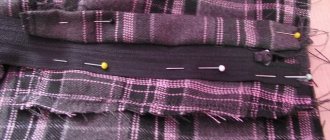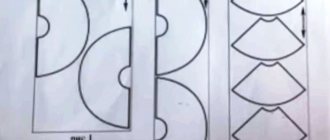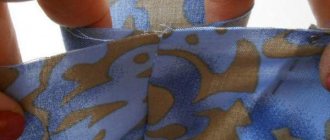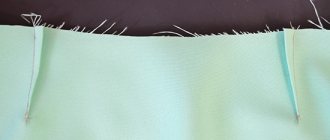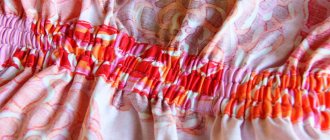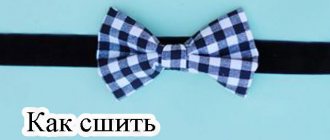A codpiece zipper, or as it is also called - with a valance, is used when sewing men's trousers and women's trousers and skirts in denim style.
This type of fastener does not have to be used in all models of women's trousers and skirts, because several layers of fabric and a zipper add extra volume in the abdominal area.
A codpiece is a slit on trousers or a skirt down to the waist, which is fastened with a zipper, buttons or snaps. It is usually located in the middle seam of the front part of the product.
The facing of the codpiece covers the zipper on the front side of the product and can be set-in or one-piece. Which half of the product the facing is on depends on who the trousers are being sewn for. For women, the facing is located on the right side, for men - on the left.
Another detail of such a fastener is the slope. This is a strip of fabric that covers the bottom of the zipper and protects our body and clothing from getting caught in the zipper teeth.
The codpiece is processed BEFORE sewing down the side and crotch seams and attaching the waistband.
Zipper with set-in codpiece facing
Fold the fabric in half with the right side inward and cut out the front part of the product with a 1 centimeter allowance on the middle seam. Its length is equal to the desired length of the zipper plus 3.5 centimeters. This allowance is needed so that the second part of the product, when we sew on the slope, covers the zipper well. The allowance can be duplicated with a shared edge (from the wrong side).
For women's trousers or skirts, cut off the allowance on the right half of the product.
We process the cuts of both halves using an overlocker.
We cut out the facing of the codpiece from the same fabric as the product itself: draw a rectangle the same length as the allowance, 4 centimeters wide, and round one corner. We duplicate the part with a universal duplicator and process the rounded side using an overlocker. For the slope detail, cut out a rectangle with a length equal to the length of the allowance on the front part of the product and a width of 8 centimeters. Next, the piece needs to be folded in half lengthwise with the right side inward and sewn with a straight stitch along one short side. The stitch can be laid slightly obliquely so that the angle is not straight. Cut off the seam allowance and turn the slope right side out. We process the free edge using an overlocker or bias tape.
We apply the facing of the codpiece to the right half of the product face to face, departing from the edge of 0.5 centimeters and attaching it to the mark (the beginning of the zipper), departing from the edge of the facing of 0.5 centimeters.
We turn away the facing as in the photo and make a line 0.2-0.3 millimeters from the edge, not reaching the end of the facing 2 centimeters.
We fold the two halves of the front with the right sides inward and sew down the middle seam 1 centimeter from the edge, not reaching the facing of the codpiece 1 centimeter (marked with a pin in the photo). The edge of the facing needs to be folded in.
On the left part with an allowance, we cut the seam perpendicular to the beginning of the line, not reaching it 1-2 millimeters.
This is necessary so that the seam can be ironed and nothing will bulge; or turn the seam over to the right side and topstitch.
On the front side of the left half of the product, we apply a zipper to the edge with the wrong side up. The lower zipper stop should be at the mark that we initially marked. Using a zipper foot, sew the zipper close to the teeth.
Now we put the slope on top, matching the edges and stitching. We unfold it as in the photo and sew a line close to the edge up to the stopper.
We turn the slope to the side and secure it with a tailor's pin.
On the front side, align the codpiece in the center and pin or baste along the edge.
Turn the pieces over to the wrong side and fold them together. Pin the facing of the zipper codpiece using tailor's pins.
Sew the zipper to the facing using two stitches: close to the edge of the zipper and close to the teeth.
On the front side, mark the stitching line for the codpiece facing as in the photo. First, lay a straight vertical stitch along the marked line, ending at the beginning of the fillet. Remove the pin that held the slope, screw it back into place and lay it flat. Sew along the marked rounded line, sewing and the slope in this place.
Make fastenings with a dense “fine zigzag” stitch on both sides of the rounded part.
This is what the finished clasp looks like from the reverse side.
And so with the front.
If the zipper is long, before trimming the excess ends, remove the top stoppers and reinstall them at the desired level by removing one tooth on each side of the zipper at this point (1.5 centimeters down from the top edge of the product).
We recommend
An easy way to sew a zipper into a codpiece with a set-in facing
And although the principle of processing a codpiece is the same, some steps may differ.
We process the cuts of the middle seam of both halves of the product using an overlocker. We duplicate an allowance of 1 centimeter on one half with an adhesive edge.
We duplicate the facing of the codpiece with a universal doubler and process it using an overlocker. We sew the slope detail.
We apply a zipper to the slope (to the overlaid cut), aligning its lower and side edges with the lower and side edges of the slope. We sew the zipper close to the teeth.
We place the slope with the zipper down on the piece with the allowance, laid right side up. Align the edges and sew, moving the sewing machine needle 1 millimeter to the left (if possible), so that the line that connects the zipper to the trim remains to the right of the main connecting stitch of the jamb to the part of the product.
To the part without an allowance, we apply the facing of the codpiece face to face, aligning the edges and stitch it at a distance of 7 millimeters from the edge (if the middle seam allowance is 1 centimeter). Then we bend the seam allowances and stitch on the front side 1 millimeter from the edge.
We cut off the seam allowance for the codpiece, leaving three millimeters.
We fold the parts of the product with the right sides inward, pin them with tailor’s pins and grind the middle seam 1 centimeter from the edge.
We finish the line at the level of the lower zipper stop.
Iron the places where the fastener parts are sewn.
We lay the codpiece evenly on the front side and pin it at the edge.
We turn it over to the wrong side, putting the parts of the product together and checking whether everything is laid evenly. Pin the unsewn zipper tape to the facing of the codpiece.
Sew the zipper to the facing, placing a stitch closer to the edge of the zipper tape.
We mark the decorative stitching. We bend the slope to the side and sew a line in a straight line, ending at the curve, making a tack at the end. We return the slope to its place and continue stitching along the rounded part, making a tack at the middle seam.
We trim the allowance so that it is hidden by the slope. If the fabric frays a lot, at the very beginning the allowance should be processed on an overlocker along with the middle seam.
View of the finished fastener.
Evolution
Few people know that during the times of knightly tournaments, when warriors wore heavy armor, such an element of combat attire as the codpiece was invented. That this is such an important invention and that it will reach our days, no one probably imagined. Of course, since those times the codpiece has changed beyond recognition.
Initially, it was a metal plate that served as a cover for the groin, its protection. This element of armor could look different - a small piece covering the male dignity, or even a rather large structure, which was attached in front above the groin, and from the back - to the belt above the buttocks.
Over time, others learned what a codpiece was. It was part of men's clothing (trousers, pantaloons), but its appearance was somewhat different than what we were used to seeing. This part was a rectangle that was attached to the trousers with buttons.
Zip fastening with one-piece codpiece facing
The one-piece facing of the codpiece is laid at the time of constructing the pattern: to the middle seam of the front part you need to add a rectangle 3.5-5 centimeters wide and 19-20 centimeters long. It can be rounded along one bottom corner, or it can be left straight.
Progress:
- Sew the middle seam to the cut mark on the fastener, folding the two front halves of the product with the right sides facing inward.
- Cut off excess fabric from the fastener allowance on the left half, leaving 1 centimeter.
- Cut out a slope equal to the length of the allowance and a width of 6 centimeters (for an allowance for facing the codpiece 4 centimeters wide), rounding the lower corners.
- Fold the slope in half with the wrong side inward and process the rounded side using an overlocker or bias tape.
- Baste the zipper under the left edge of the fastener, and baste the slope under it, aligning the edges. Sweep away all layers.
- On top of the zipper, along the edge, lay a stitch 2 millimeters from the edge.
- Process the right one-piece facing of the codpiece using an overlocker, then turn it inward and iron it.
- Pin the facing to the zipper tape.
- From the wrong side, unscrew the flap and the zipper tape so that it is convenient to lay the stitch. Turn the product right side out and mark a line of decorative stitching.
- Sew along the marked line. Make a fastening at the bottom of the codpiece facing with a narrow, frequent zigzag stitch.
Covering up the secret
The codpiece in the photo is an element of classic trousers (less often skirts). It is a fabric part that covers the slit between the left and right halves of the pants, fastened with a zipper, snaps or buttons. Another, but less well-known name for such an element of clothing is valance. It is very important for novice tailors to initially understand how important it is to be able to cut out and correctly sew in a codpiece, what it is in general, because this is perhaps the most significant place in trousers.
The codpiece is located in the front of the pants, in the most visible place; if it is sewn incorrectly, then the pants will sit unattractively, and such pants will be uncomfortable to wear. In addition, it is also necessary to learn to distinguish between concepts such as codpiece and slope. The first is the outer part behind which the fastener is hidden, the second is a piece of fabric that prevents underwear, underwear or skin from getting caught in the teeth of the zipper; a flap is inserted under the zipper.
Notes[ | ]
- Gulf // Explanatory dictionary of the living Great Russian language: in 4 volumes / author's compilation. V. I. Dal. — 2nd ed. - St. Petersburg. : Printing house of M. O. Wolf, 1880-1882.
- ↑ 123
Plekhanova E. O. History of costume, textile and jewelry art: textbook. - Izhevsk: Udmurt University Publishing House, 2013. - 218 p. - Francis Kelly, Randolph Schwabe. History of costume and armor. From crusaders to court dandies. // Tsentrpoligraf, 2008. P. 53.
- ↑ 12
Valerie Cumming, C. W. Cunnington, P. E. Cunnington. The Dictionary of Fashion History. Berg, 2010. P. 60. - Susan J. Torntore. Breeches. // Lovetoknow.com.
- Lindbergh, Jennie. Buttoning Down Archeology Archived July 5, 2021 on the Wayback Machine. // Australasian historical archaeology, 17, 1999. P. 52.
- Stephen Scott. Why Do They Dress That Way? Good Books, 1996. P. 114.
- Richard T. Schaefer, William W. Zellner. Extraordinary Groups: An Examination of Unconventional Lifestyles. Macmillan Publishers, 2010. P. 42.
- Robert Friedel. Zipper: An Exploration in Novelty. WW Norton & Company, 1996. P. 187.
- Robert Winder. Hookless hookers: the battle of the fly. The Independent, 22 April 1995.
- Jaeil Lee, Camille Steen. Technical Sourcebook for Designers. A&C Black, 2014, p. 93.
- Lynn MacIntyre, Marcy Tilton. Easy Guide to Sewing Tops and T-Shirts, Skirts, and Pants. Taunton Press, 2009, p. 323.
- Codpiece Archived copy from November 11, 2014 on the Wayback Machine (inaccessible link since 06/14/2016). // Krysin L.P. Explanatory dictionary of foreign words. - M.: Eksmo, 2008. - 944 p.
- T. F. Efremova.
codpiece // Explanatory dictionary of Efremova (Russian). — 2000.. // Explanatory Dictionary of Efremova. T. F. Efremova. 2000. - fly // Dictionary of Russian synonyms (Russian).. // Dictionary of Russian synonyms.
- ↑ 12
Zakharzhevskaya R.V. History of costume: From antiquity to modern times Archival copy dated October 31, 2014 on the Wayback Machine. 3rd ed., additional - M.: RIPOL classic, 2005. 288 p. - T. Tretyakova. "History of costume (XVI-XVIII centuries): textbook." When the trousers began to look like stockings, a codpiece was needed.
It was a bag that covered the joint, also fastened to the trousers using suspenders . - Igor Semenovich Kon. The male body in cultural history. Slovo, 2003. P. 175. Section “A Century of Codpieces”: In Russian literature, in particular in translations by Rabelais, this special form of fly is called a codpiece
. - EdwART.
Bragett // Encyclopedia of fashion and clothing (Russian). — 2011.. // Fashion Encyclopedia. Andreeva R., 1997. - Beth Marie Kosir. Modesty to Majesty: The Development of the Codpiece
- M. M. Bakhtin. Forms of time and chronotope in the novel. Chapter VII. Rabelaisian chronotope.
Terminology
In Russian literature, three terms are used to designate this item of clothing: “codpiece”, “fly”, “ bragette”
"(from French braguette). Sources differ on the exact meaning of these terms and their correspondence to the three types of codpiece: flap (English drop fall, fall fly), pouch (English codpiece), modern cut (English fly front; in English there is also a phrase for the fastening of trousers at the back, English fly back).
Most dictionaries consider “codpiece” and “fly” to be synonyms. Some authors emphasize the evolution of the word "codpiece" from a piece of fabric attached to trousers to the modern "front placket of trousers."
Codpiece (14) in GOST 22977-89
- GOST 22977-89 defines the codpiece as part of the trouser fastener (part with button loops).
- Some authors use the term “codpiece” only to describe the pouch in historical costume, as a special type of fly.
- "Bragette" (sometimes "bragget") is used only when describing historical costumes, usually the pouch codpiece.
R.V. Zacharzhevskaya also uses the word “pont” to refer to the codpiece-valve.
Story
Lederhosen with codpiece valve
In Western European historical costume, the codpiece was made in the form of a flap, fastened to the front of the belt and covering the slit in the trousers. This cut is still used in folk clothing, such as German lederhosen, and is also traditionally used in sailor trousers.
Codpiece-pouch in a painting by Pieter Bruegel the Elder (1565)
From the 13th-14th centuries, men began to wear stockings, along with a triangular flap-codpiece, decorated with ribbons and fringe. At the beginning of the 15th century, the codpiece turned into a voluminous pouch covering the groin; this form remained popular until the end of the 16th century. Since the 16th century, men switched from shoss to breeches, which had a front closure with buttons.
After the shortening of vests in the 18th century, the top of the breeches was open and to improve the appearance in the 1730s, a wide flap appeared on the trousers, fastened to the belt and covering the opening in the trousers (clasps with uncovered buttons remained, but went out of fashion).
A codpiece resembling a modern one (on “trouser” buttons covered with a strip of fabric) appeared in the 1820s (some researchers date the appearance of the trouser buttons themselves to 1823, others to the appearance of “American” suspenders in 1787). At first, the new cut met with resistance. So, in 1830, the English magazine. The Gentleman's Magazine of Fashion described the new codpieces as "indelicate and disgusting." The flap codpiece remained popular until the 1840s, and in riding clothing until the end of the 19th century; the new style was never adopted by some groups, such as the "Old Order" Amish.
The rise of the zipper in codpieces stems from an intense advertising campaign by American zipper manufacturers (then centered around Hoboken, New Jersey) in the mid-1930s, which one of its creators, Sam Kinney, described as the "battle of the codpiece." The advertising campaign actively used “gaposis”: complaints invented by the authors of the advertisement about the gaps remaining between the buttons of the fastener, which gave air, light and indiscreet eyes unwanted access to the body.
Materials and tools
To sew a zipper to your trousers you will need:
- sewing machine with overlock foot and regular zigzag;
- the lightning itself;
- a rectangle of fabric from which the slope will be made;
- trousers with a one-piece codpiece;
- iron;
- ruler;
- needle, thread, tailor's pins, scissors, chalk.
Many people cannot work with a thimble, but trouser fabric can be quite thick, so it is better to include it in the list of tools. You also need to take care of sufficient illumination of the workplace, because work requires utmost attention.
Algorithm for sewing a zipper into products tailored without a fastener
It happens that the pants are initially cut without a fastener. Sewing a zipper into them is quite simple. To do this, you must correctly complete the following steps:
- Open the center seam at the front where the fastener is planned.
- Lay out the pants on a flat surface, place the fastener on them and mark the places where it will be sewn.
- With this sewing method, the zipper will not have a valance, so you can step back about 2 cm from the mark on the right and cut off the excess fabric.
- Turn the pants inside out, position the fastener, and pin it.
- Sew on one side of the fastener. To make sure that everything is in order - the zipper is working properly and nothing is interfering with it - you must unfasten the slider several times.
- Close the fastener and sew the second band to the other half of the trousers.
- After this, all that remains is to sew the pants along the seam in the groin area and iron the finished fastener.
In order to sew a zipper into pants, no special knowledge or skills are required. Desire and a little free time are the key to success. Even a woman who has no experience in this matter can sew a zipper into trousers, as well as properly process the codpiece fastener.
Important points
Sewing on the codpiece, which is the front part of the trousers and is also quite functional, requires care. An unsuccessfully opened zipper can simply “chew the fabric”, and then it will be difficult to avoid an incident. To protect yourself in advance from such awkwardness, you should not widen or narrow the codpiece; the zipper is sewn not to the trousers, but to the valance - this is a fundamental point.
There is a difference in how to sew a codpiece into women's and men's trousers. Thus, it is believed that the codpiece is attached to the right side of women's trousers, while for men, on the contrary, this part needs to be inserted into the left half of the trousers. If thin fabric is used for sewing, it is better to duplicate the codpiece and the slope, so the material will not wrinkle. However, this should not be done with thick fabrics - the product may turn out to be too rough.
Codpiece as a piece of clothing in our time
Over the course of a long evolution, the codpiece turned from a separate flap or pocket into a part of trousers. Currently, it is a zipper or button closure covered with a flap.
In addition to trousers, codpieces are now also found on men's underwear: briefs, leggings, men's tights, etc. In these products, the codpiece is a kind of vertical wedge that supports the male genital organ and ensures the convenience of performing natural needs.
Men's tights with codpiece
The recognized leader in the manufacture of men's underwear is the French company HOM, which in 1968 patented underwear with a flexible codpiece. And in 1997, the same company began to produce underwear with a horizontal codpiece. The vertical wedge was convenient primarily for right-handed people, but it created some difficulties for left-handed people when using it. The horizontal position of the codpiece made it universal for everyone.
Currently, the codpiece, although hidden from prying eyes, is still an important detail. It should ensure a comfortable position for the male genital organ, because a man’s health depends on it
That is why codpieces must be made from natural materials, even if the panties themselves are completely synthetic.
Having gone through a long evolution, the codpiece as a visible part of protective clothing remained only with hockey players. This, as you know, is the sport of real men, and men's health in hockey, a dynamic and contact game, is in serious danger. Currently, the codpiece is made comfortable, but invisible. Now, if it occurs to anyone to buy underwear with a decoration on the codpiece, it will be nothing more than a joke that will not go beyond the walls of the bedroom.
